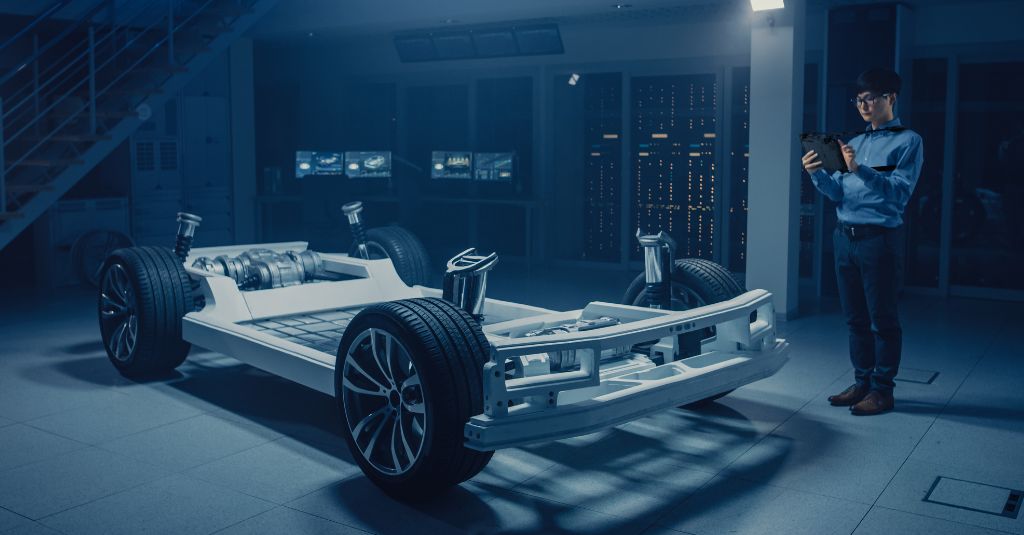Artificial intelligence (AI) has been on the lips of every CEO and business leader this year. Ever since the launch of OpenAI’s generative-AI program ChatGPT in November 2022, companies have been scrambling to adopt AI technologies in their daily workflows and thereby “future-proof” their businesses by leveraging sophisticated AI capabilities. The estimated market size of the US AI industry is projected to grow significantly, reflecting the increasing adoption and integration of AI across various sectors. While the value of the global market for AI products and services is set to increase ninefold over the coming decade, important criticisms have also been made of the hype in the discourse around AI by experts such as Daron Acemoglu, who points out that the set of tasks which may have potential for full automation through AI is more limited than many proponents claim. In fact, companies will need to pursue “fusion strategies“, by leveraging their human capital and industry-specific expertise to integrate AI into their current work processes.
This is especially the case for rugged industries, where the transformative potential of AI meets the reality of challenging working environments, where heavy technical equipment is used to perform physically strenuous tasks. In industries ranging from natural-resource extraction and utilities to manufacturing and logistics, among others, technologies such as predictive analytics, automated robotics, and computer vision can help to make production sites more reliable, more efficient, and safer for employees. Business leaders are right to embrace the technologies of the future, but this embrace requires a pragmatism in understanding how AI is applicable in the here-and-now for their industries and which investments need to be made to enable the adoption of AI technologies. This article outlines current trends in AI for rugged industries, with a look at both technologies currently being integrated into work processes, as well as future trends which actors in these industries should be aware of.
Reality Check: The State of Artificial Intelligence Adoption in Rugged Industries
The benefit of AI for rugged industries is that it comes at the apex of a suite of technologies that are defining the fourth industrial revolution, be it autonomous robots, wearable technologies, rugged devices, or AI tools. While each specialist may have a grasp on the specific technology that they use in their daily work, it would be impossible for any human to keep on top of the whole range of technologies in use in their industry. That’s where AI comes in – it can orchestrate the interaction of these technologies by utilizing machine-learning algorithms to analyze a quantity of data that would simply not be possible for human analysts to keep track of. This orchestration provides a competitive advantage by optimizing processes and enhancing decision-making in rugged industries.
This application of AI technologies in heavy industries is predicted to particularly boost growth in the manufacturing, transportation and storage, construction, and agricultural sectors, while the size of the global market for AI in manufacturing alone is forecast to increase sixfold, to over USD 20 billion by 2028. Generally, the use cases of AI in these industries can be broken down into three categories: guiding the maintenance of technical systems in challenging work environments; increasing efficiency and streamlining work processes; and improving health, safety, and security. While these three categories are interrelated – so that a well-functioning monitoring system will increase both efficiency and safety – for the purposes of this article, we’ll consider them in turn.
Maintenance of Technical Systems with AI Tools
Heavy industries rely on complex technical systems and AI models for their daily work, which can often slow down, malfunction, or even crash due to harsh environmental conditions, such as extreme heat, precipitation, dust, or other hazards. By using machine learning to analyze sensor data from equipment, companies can proactively predict and manage potential failures in their technical systems, minimizing downtime in their operations.
Examples of these predictive maintenance technologies would be in natural-resource extraction industries, where AI programs can monitor real-time data on pressure, vibration levels, and temperature to look for deviations from normal operating conditions which would suggest malfunction, or, in the utilities industry, where automated inspections of remote assets such as power lines and pipelines can be managed through drones using computer-vision technology to detect anomalies.
Increasing Efficiency with AI Capabilities
Heavy and rugged industries rely heavily on logistics planning, as their business models revolve around transporting physical goods along complex supply chains. The potential for AI to optimize supply chain management and aid decision-making is huge. The market value of AI in increasing efficiency is projected to grow significantly, driven by its ability to enhance productivity and reduce costs. Machine-learning models can analyze vast amounts of data, suggesting solutions at each step of the supply chain process. Companies can plan production schedules through AI-driven demand forecasting and inventory management, while during the production process assembly lines and production sites can be monitored and quality control automated through computer vision.
When it comes to getting the finished products to customers, delivery patterns can be optimized through machine learning and delivery infrastructure. The importance of increasing efficiency in the supply chains of rugged industries is growing due to the global labor shortage for roles like warehouse managers and logistics professionals. This trend is even worse for truck drivers, with an estimated three million unfilled positions worldwide. Leveraging AI to overcome these supply chain issues and optimize work processes can lead to significant competitive advantages in increasingly data-driven and resource-constrained global markets.
Improving Health and Safety
While AI offers significant opportunities for companies in heavy industries to gain a competitive edge, it’s also crucial to recognize how these technologies can improve the work lives of employees through better managing health and safety procedures. Natural language processing (NLP) plays a vital role in improving health and safety by enabling more effective communication and data analysis. By leveraging AI and Internet of Things (IoT) data, companies can make informed decisions about worker safety, such as through data-driven real-time risk assessment, automated hazard-detection systems, autonomous robots for high-risk operations, and hi-tech wearables and sensors. As around two-thirds of workplace accidents occur in the construction, transportation, manufacturing, and agricultural sectors, the proper integration of AI into the workplace has massive potential to improve health and safety in these challenging work environments.

Industrial AI enhances emergency response by providing real-time data, predictive analytics, and efficient resource allocation, improving decision-making and safety.
What’s Next for AI in Rugged Industries?
As the previous section demonstrates, AI research has the potential to upend the status quo in rugged industries, providing solutions to problems as varied as unpredictable environmental conditions, labor shortages, or supply chain issues. The generative AI market is also evolving rapidly, offering new applications and insights into different AI technologies. While the majority of companies are still only at the beginning of their data journey, with a long way to go in ensuring they are effectively utilizing current AI technologies, it is also important to keep in mind future developments that may further transform the AI landscape for rugged industries.
Edge Computing
The clearest development that will further enable the use of AI in rugged industries is that of edge computing. Put simply, this is the decentralized processing and analyzing of data using equipment close to the source, rather than sending data to a centralized cloud computer. This is beneficial as the scale and complexity of data produced by IoT devices has grown massively, creating delays due to limited bandwidth.
The benefits of edge computing for the use of AI in rugged industries are clear – these industries rely on field work in challenging environments, where sending large amounts of data over a network is impractical or impossible. Edge computing allows AI programs to analyze data in real time at the source, better enabling the previously discussed use cases, such as predictive maintenance and automated robotics.
Sustainability
AI’s role in optimizing the use of resources, extending the lifespan of equipment through predictive maintenance, and using early-warning systems for detecting sustainability risks in supply chains will be vital in ensuring that rugged industries are prepared for the transition to a green and sustainable economy during the 2020s. Of course, the challenging environmental conditions often faced in rugged industries like extreme temperatures, moisture, dust and vibrations may compound sustainability problems by accelerating equipment degradation and resource depletion.
The durability and resilience of rugged devices and sensors on which AI programs rely for data collection and processing in the field become a critical issue. Frequent replacements due to failures can increase e-waste and resource consumption. This is why investments in ruggedized, environmentally hardened technological infrastructure are necessary to enable the AI-driven sustainability improvements that are so essential for these industries to reduce their environmental footprint in the long run.
Ethical Considerations
It’s important to keep in mind the limitations of AI when integrating these technologies into work processes. AI is a powerful tool that can lead to vastly improved business practices, but it can also be subject to some of the same errors and biases that human actors are. AI algorithms must be unbiased and explainable to prevent equipment failures that could endanger the health of workers in these rugged industries. Human oversight over AI is still a powerful corrective to these biases, particularly when AI development teams are suitably diverse and inclusive of people with different roles, backgrounds, and experiences.
The data that is analyzed by AI algorithms must also be handled with the utmost security, ensuring that personal and privileged information is stored securely, ensuring privacy and regulatory compliance. As governance of AI systems is constantly evolving, actors in rugged industries must stay on top of regulatory developments, being leaders in the adoption of best practices and thereby building trust and fostering public confidence.
Conclusion
AI is already transforming the daily work of rugged industries through technologies such as machine learning, computer vision, and automated robotics. The use cases of these technologies provide clear benefits: predictive maintenance can help businesses to minimize downtime of equipment; supply-chain optimization can get products from A to Z faster and with less resource use; and automated monitoring of data from IoT equipment can help to ensure worker safety in even the most challenging work environments. Other advances such as edge computing will further enable the real-time processing of data using AI, while an increasing focus on sustainability will turn AI towards resource optimization and environmental-risk warning systems.
Rugged sectors are an important testing ground for AI, as this revolutionary technology comes up against the challenges of harsh conditions and integration with legacy systems. As enabling factors such as computing infrastructure, data access, and the accessibility of AI technologies to business are scaled during the 2020s, the adoption and innovation of AI in rugged industries will accelerate. Leaders in these industries must prioritize AI adoption to prepare their businesses for a future where technology enables sustainable growth and innovation. Investing in the infrastructure, hardware, and skills needed to harness these technologies is essential to future-proof business in rugged industries in an increasingly AI-driven world. And let’s face it: even though, for these industries AI is not the new kid on the block, we are still at beginning of a very long AI journey, so it’s worth getting started now!
SOURCE:www.getac.com


